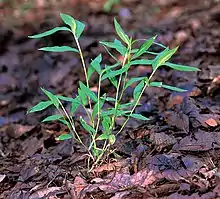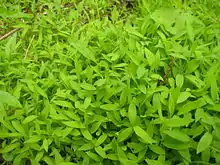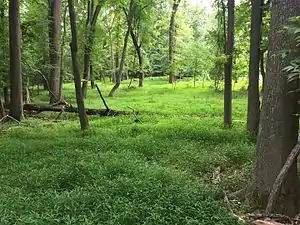Microstegium vimineum
Microstegium vimineum, commonly known as Japanese stiltgrass, packing grass, or Nepalese browntop, is an annual grass that is common in a wide variety of habitats and is well adapted to low light levels.
| Japanese stiltgrass | |
|---|---|
 | |
| Single specimen of Japanese stiltgrass (Microstegium vimineum), a non-native invasive plant in the United States | |
| Scientific classification | |
| Kingdom: | Plantae |
| Clade: | Tracheophytes |
| Clade: | Angiosperms |
| Clade: | Monocots |
| Clade: | Commelinids |
| Order: | Poales |
| Family: | Poaceae |
| Subfamily: | Panicoideae |
| Genus: | Microstegium |
| Species: | M. vimineum |
| Binomial name | |
| Microstegium vimineum | |
Despite being non-native in the United States, it serves as a host plant for some native satyr butterflies, such as the Carolina satyr Hermeuptychia sosybius[1] and the endangered Mitchell's satyr Neonympha mitchellii.[2] Owing to its invasive potential, the plant has been put on the European list of invasive alien species.[3] This means the plant can no longer be imported into or traded in the European Union.[4]
Distribution
Microstegium viminium is native to many parts of Asia from Turkey in the west to Japan in the east. In East Asia it is found in China, Japan, the Russian Far East, North Korea, South Korea, and Taiwan. In South East Asia its native range includes Malaysia, Myanmar, the Philippines, Thailand, Laos, and Vietnam. In South Asia it occurs in Bhutan, India, and Nepal. In West Asia, particularly in the Caucasus and the Black Sea and Caspian Sea coasts, it can be found in Turkey, Georgia (country), Iran, and in Sochi in Russia.[5][6]
The species has also been introduced extensively beyond its native range. In North America it is established throughout the Midwestern United States, the Southeastern United States, the West South Central United States, the Northeastern United States, and southern Ontario in Canada.[5][6]
Description
It typically grows to heights between 40 and 100 cm (1.3 and 3.3 ft) and is capable of rooting at each node. The plant flowers in late summer and produces its seeds in the form of a caryopsis shortly thereafter.[5][6] It is quite similar to and often grows along with the North American grass Leersia virginica, but L. virginica lacks the distinctive silver stripe on the center of the leaf that is present on Japanese stiltgrass and also flowers one to two months earlier.[5][7]
The plant is known to be a common habitat for ticks such as the lone star tick. Browsing deer often transport these ticks into other areas where they can expand.
 At Congaree National Park, South Carolina, United States
At Congaree National Park, South Carolina, United States At Devil's Den State Park, Arkansas, USA
At Devil's Den State Park, Arkansas, USA Near a stream in Central New Jersey, USA
Near a stream in Central New Jersey, USA Illustration from Wetland flora: Field office illustrated guide to plant species
Illustration from Wetland flora: Field office illustrated guide to plant species Seeds (caryopses)
Seeds (caryopses)
Invasive species ecology

The plant was accidentally introduced into the U.S. state of Tennessee around 1919 as a result of being used as a packing material in shipments of porcelain from China. It has spread throughout the Southeastern U.S. and is now found in 26 states.[8] Microstegium vimineum most commonly invades along roads, floodplain and other disturbed areas, but will also invade undisturbed habitats.[9][10][11] Whitetail deer, which do not browse the grass, may facilitate spread by browsing on native species and thereby reducing competition for the exotic plant.[12] Invasion of Microstegium can reduce growth and flowering of native species,[13] suppress native plant communities,[14] alter and suppress insect communities,[15] slow plant succession[16] and alter nutrient cycling.[17][18] However, removal of Microstegium can lead to recovery of native plant communities.[19][20][21]
Stiltgrass is currently an invasive foreign species in the United States, and if not eradicated, will quickly spread and take over lawns and woodland floors. The seed can remain viable in the ground for several years. It can be managed best before it sets seed. In the mid western states, this is usually at the beginning of September.
Control
As this grass is an annual, in order to be effective, mowing must be performed before the plants go to seed.[22][23]
References
- "Butterflies of North Carolina". NC Parks Service. Retrieved 2017-12-06.
- "Host and Nectar Plants". USF Water Institute. Retrieved 2017-12-06.
- "Union list of invasive alien species". June 2021.
- "European IAS Regulation".
- Thieret, John W. (2006), "Mictrostegium", in Flora of North America Editorial Committee, eds. 1993+ (ed.), Flora of North America, vol. 25, New York & Oxford: Oxford University Press
- Chen, Shou-liang ; Phillips, Sylvia M. (2007), "Microstegium vimineum", in Wu, Z. Y.; Raven, P.H.; Hong, D.Y. (ed.), Flora of China, vol. 22, Beijing: Science Press; St. Louis: Missouri Botanical Garden Press, p. 593, retrieved 2007-07-14
{{citation}}: CS1 maint: multiple names: authors list (link) - Swearingen, Jil M.; Adams, Sheherezade (2006). "Japanese Stiltgrass". Plant Conservation Alliance's Alien Plant Working Group. National Park Service. Retrieved 2007-06-27.
- USDA, NRCS. 2012. The PLANTS Database (http://plants.usda.gov, 19 August 2012). National Plant Data Team, Greensboro, NC 27401-4901 USA.
- Redman, D.E. 1005. Distribution and habitat types for Nepal Microstegium (Microstegium vimineum) in Maryland and the District of Columbia. Castenea, 60:270-275
- Cole, P.G. and J.G. Weltzin. 2005. Environmental correlates of the distribution and abundance of Microstegium vimineum in east Tennessee. Southeastern Naturalis, 3:545-563.
- Moretensen, D.A., E.S.J. Rauschert, A.N Nord and B.P. Jones. 2009. Forest roads facilitate the spread of invasive plants. Invasive Plant Science and Management. 2:191-199
- Knight TM, Dunn JL, Smith LA, Davis J, Kalisz S (2009) Deer facilitate invasive plant success in a Pennsylvania forest understory. Nat Areas J 29:110–116
- Bauer, J.T. and Flory, S.L. 2011. Suppression of the woodland herb Senna hebecarpa by the invasive grass Microstegium vimineum. American Midland Naturalist. 165:105-115.
- Flory, S.L. and K. Clay. 2010. Non-native grass invasion alters native plant composition in experimental communities. Biological Invasions 12:1285-1294
- Simao, M.C., S.L. Flory, and J.A. Rudgers. 2010. Experimental plant invasion reduces arthropod abundance and richness across multiple trophic levels. Oikos 119:1553-1562.
- Flory, S.L. and K. Clay. 2010. Non-native grass invasion suppresses forest succession. Oecologia 164:1029-1038.
- Ehrenfeld, J.G. 2003 Effects of exotic plant invasions on soil nutrient cycling processes. Ecosystems 6:503–523
- Lee, M., S.L. Flory, and R. Phillips. 2012. Positive feedbacks to growth of an invasive grass through alteration of nitrogen cycling. Oecologia. DOI: 10.1007/s00442-012-2309-9
- Flory, S.L. 2010. Management of Microstegium vimineum invasions and recovery of resident plant communities. Restoration Ecology. 18:103-112
- Flory, S.L. and K. Clay. 2009. Invasive plant removal method determines native plant community responses. Journal of Applied Ecology. 4:434-442.
- DeMeeste, J.E., Richter, D.D. 2010. Restoring restoration: removal of the invasive plant Microstegium vimineum from a North Carolina wetland. Biological Invasions 12:781–793
- Kleczewski, N.; Flory, S.L.; Nice, G. (2011). "An Introduction to Microstegium vimineum (Japanese stiltgrass/Nepalese browntop) an Emerging Invasive Grass in the Eastern United States" (PDF). Indiana University Department of Biology. Archived from the original (PDF) on 2017-03-09.
- Nitzsche, Peter. "Japanese Stiltgrass Control in the Home Lawn and Landscape". New Jersey Agricultural Experiment Station. Retrieved July 22, 2021.
External links
- NPS Plant Invaders of Mid-Atlantic Natural Areas: Japanese Stilt Grass
- Maine Invasive Plants: Japanese Stilt Grass, University of Maine
- Species Profile of Microstegium vimineum (Japanese Stilt Grass)—United States National Agricultural Library, National Invasive Species Information Center. Lists general information and resources for Japanese stilt grass
- Microstegium vimineum in Guide to Invasive and Hegemonic Grasses
- Japanese stilt grass | Wisconsin DNR
- Japanese stiltgrass - Invasive Plants Association of Wisconsin